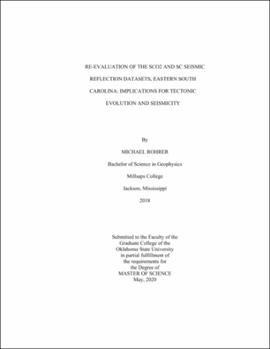| dc.contributor.advisor | Knapp, James H. | |
| dc.contributor.author | Rohrer, Michael | |
| dc.date.accessioned | 2020-09-09T21:48:14Z | |
| dc.date.available | 2020-09-09T21:48:14Z | |
| dc.date.issued | 2020-05 | |
| dc.identifier.uri | https://hdl.handle.net/11244/325538 | |
| dc.description.abstract | Identification and characterization of the Paleozoic Suwanee basin sedimentary sequence and the associated Pangea supercontinent transcurrent fault are critical in furthering our present understanding of tectonic history and its impacts today. However, explicit bounding of the Suwannee basin has manifested itself as difficult to delineate due to thick coastal plain cover, lack of well control and petrophysical analysis, and sparse seismic reflection data. The objective of this study is to present the results and analysis of two 2D seismic reflection datasets: 1) SC reflection profiles (collected 1979) and 2) SCO2 reflection profiles (collected December 2010 to January 2011) that demonstrate the prominent regional presence of a previously uninterpreted Paleozoic sedimentary section, the Suwannee basin sequence, near the Middleton Place Summerville Seismic Zone (MPSSZ) in onshore Eastern South Carolina, as well as associated structural deformation. Previously identified offshore, this package of low-frequency, near horizontal, laterally continuous reflectors are clearly separate and distinct from overlying Jurassic/Triassic sequences above the post-rift unconformity (PRU). The interpreted base of the Paleozoic sequence is defined by the lack of laterally continuous seismic reflectors marked by crystalline basement presence. It is believed that the Suwannee basin sequence can be mapped continuously over the entire study area, which is roughly 7,010 km2. Similar sedimentary sequences recognized from onshore exploration wells in Florida have been identified as part of the Suwannee basin sequence of Gondwanan origin. Identification of the presence and extent of these Gondwanan strata onshore implies: (1) the position of the Pangea supercontinent transcurrent fault lies roughly <40 km further northwest of the study area; (2) previously identified terranes (Brunswick, Charleston, Suwannee, Northern Florida) combine to represent Gondwana based on the size and presence of stable platform stratigraphy; (3) intraplate seismicity that occurs within the MPSSZ may be attributed to faulting observed within the study area. | |
| dc.format | application/pdf | |
| dc.language | en_US | |
| dc.rights | Copyright is held by the author who has granted the Oklahoma State University Library the non-exclusive right to share this material in its institutional repository. Contact Digital Library Services at lib-dls@okstate.edu or 405-744-9161 for the permission policy on the use, reproduction or distribution of this material. | |
| dc.title | Re-evaluation of the SCO2 and SC seismic reflection datasets, eastern South Carolina: Implications for tectonic evolution and seismicity | |
| dc.contributor.committeeMember | Knapp, Camelia | |
| dc.contributor.committeeMember | Abdelsalam, Mohamed | |
| osu.filename | Rohrer_okstate_0664M_16773.pdf | |
| osu.accesstype | Open Access | |
| dc.type.genre | Thesis | |
| dc.type.material | Text | |
| dc.subject.keywords | eastern south carolina | |
| dc.subject.keywords | middleton place summerville seismic zone | |
| dc.subject.keywords | seismicity | |
| dc.subject.keywords | suwannee basin | |
| dc.subject.keywords | tectonics | |
| thesis.degree.discipline | Geology | |
| thesis.degree.grantor | Oklahoma State University | |
